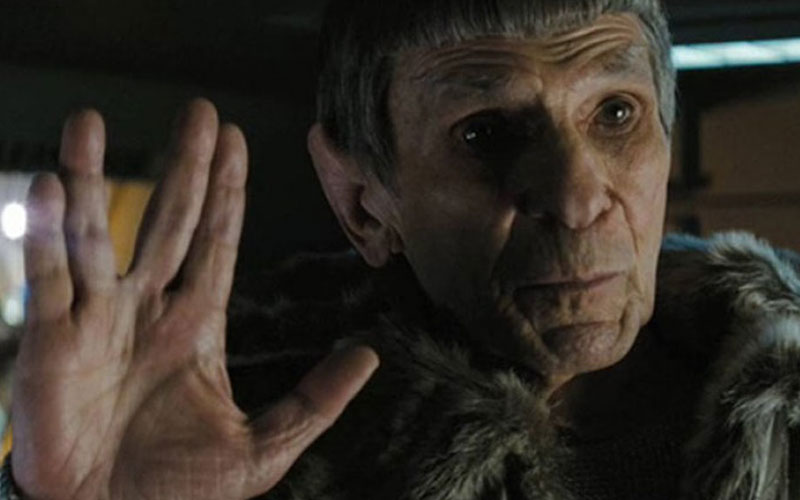The word icon is used ubiquitously today, sometimes to describe characters or symbols that are actually transitory or niche in nature and for which that moniker does not arguably apply. There is little doubt, however, that word icon applies to the character of Spock. There are few characters in popular culture that have lasted as long and whose visual and personality qualities are so identifiable and unique. The news about the recasting of Spock for season 2 of Star Trek: Discovery got us thinking about what that news means for the character and about recasting in Star Trek history.
Recasting Spock
There are many people to credit for giving Spock his iconic status. First, of course, is Gene Roddenberry, the character’s creator, and his writing team, including D.C. Fontana and Gene Coon. Credit is due to those who worked on Spock’s iconic look, especially makeup artist Fred Phillips and costume designer William Ware Theiss. Composers such as Gerald Fried created the music that emphasized the character’s emotional underpinnings. During the movie era, writer/director Nicholas Meyer and producer Harve Bennett helped give the character a second life… and an iconic death.
Then, without exaggeration being possible, are the contributions to the character by actor Leonard Nimoy. Nimoy was literally born to play the role, with his real-life experiences and pre-Trek acting work being a study in the challenges and rewards of living a life of duality. Born the son of immigrants Mordko “Max” Nimoy and Dora Spinner, who escaped the pogroms of the Ukraine to establish a new life in the United States, Leonard had his foot in two worlds… that of his home in America and that of the Yiddish and Kosher traditions of his grandparents and parents. As a youth, Nimoy was emotionally affected by Charles Laughton’s portrayal of Quasimodo in 1939’s The Hunchback of Notre Dame, a character like Spock who was visually different yet still tried to contribute. Nimoy would play characters like the disfigured Paul Baroni in Kid Monk Baroni, wearing prosthetics that set him apart from the world around him as he sought acceptance. Personally and professionally, these experiences with duality would serve as inspiration for how to play the Spock character, the child of two worlds.


Leonard Nimoy as Spock | CBS Home Entertainment
Indeed, while Nimoy was guest starring on Roddenberry’s pre-Trek show The Lieutenant, the writer/producer informed Nimoy that he was creating a science fiction show and thought he would be perfect for the alien character. While watching Nimoy on set, Roddenberry was impressed with Leonard’ acting ability and inspired to give the character of Spock angular features and pointed ears. Nimoy would use his all his talents and experiences to make Spock something unique, giving the character a life no other actor could have and in doing so, creating one of the most meaningful and memorable characters.


Jacob Kogan as young Spock in 2009’s Star Trek | Paramount Pictures
The news that the character of Spock would be recast for Discovery then comes with this history and weight behind it. Certainly, the character of Spock, both Prime and Kelvin versions, have been played by many actors throughout the years. Leonard Nimoy originated the role, playing it for 49 years, beginning with the filming of “The Cage” in November 1964 until his final onscreen appearance in 2013’s Star Trek Into Darkness. When younger versions of Spock were needed, younger actors were brought in to play the role temporarily (Billy Simpson voiced young Spock in The Animated Series episode “Yesteryear,” Carl Steven, Vadia Potenza, Stephen Manley, Joe E. Davis, and voice actor Frank Welker played Spock at various ages in Star Trek III: The Search for Spock and Jacob Kogan played young Kelvin Spock in 2009’s Star Trek). Spock has been seen as a baby during both Star Trek V: The Final Frontier and during the 2009 film’s deleted scenes where Spock was played by Jenna Vaughn, the only female to play Spock. Acting opposite Leonard Nimoy as Prime Spock in the Kelvin films was Zachary Quinto who both made the role his own and demonstrated a respect for the original characterization.


Zachary Quinto as Spock | Paramount Pictures
It is important to note, however, that Quinto was not playing the same exact character as Nimoy. Kelvin Spock’s life has been different than his Prime Universe counterpart, chief among the loss of Vulcan and his mother. And it should also be noted that each of the versions of Spock mentioned above that necessitated new actors to play the role were not technically recastings, as they were either temporary in nature or from another universe. In each instance, Nimoy had a hand in approving, guiding, or working alongside those actors as they played Spock.
Many other franchise deal with the recastings of main characters – Superman, James Bond, Wonder Woman, and even Winnie the Pooh, have their characters played by different actors for different iterations and generations. For many fans, the actor or actress who played the role when they were first introduced to that character becomes their favorite and definitive version. Many of our college students, for example, are fans of the prequel Star Wars films more than the 1970s-1980s originals because, as they tell us, those are the films they grew up on.
Star Trek has never really had to deal with the recasting concerns. The Kelvin Universe has different versions of the character who are meant to be biologically similar, but not necessarily socially or personality-wise the same exact characters as those from the original Star Trek. Whether the Kelvin films qualify as recasting then is open to debate. Sometimes guest roles have been recast (Saavik, Harry Mudd, Sarek, Amanda Grayson, Moogie, Tora Ziyal, the Borg Quen, and Alexander Rhozenko are a few examples), but not a main character, setting aside the unusual circumstance of Dax in Deep Space Nine. Now, really for the first time, Prime Spock is being recast, played by Ethan Peck.


Actor Ethan Peck with the Nimoy Family | Twitter
Recasting is important because popular culture tends to forget characters who are not reinvented for new generations. Luigi Basco was one of the most popular characters in America during the 1940s and 1950s, an Italian immigrant whose adventures were shared in the CBS radio show Life With Luigi. Today, few people would recognize that character’s name despite its resonance 80 years ago because Luigi has never been reintroduced to subsequent generations.
We think Spock deserves to be like Superman and James Bond – to continue to inspire and to resonate beyond now and into the future. There will always be people dealing with dualities…and Spock can help them as a role model because he is a character who contributes and is respected because of his dualities. Indeed, Spock’s dualities often save the day…or the galaxy.


Nimoy as Spock in Star Trek Into Darkness | Paramount Pictures
It is rough not to have Leonard Nimoy here to guide us anymore, to serve as the conscience of Star Trek, and to help new actors step into the iconic role he originated. But we think it is a tribute to him and to the character that he, along with Roddenberry, Fontana, Coon, Phillips, Theiss, Freid, Meyer, and Bennett helped create and give life to if the character of Spock endures. And hopefully, any new actors who play the role will inspire new generations to revisit the original and see the brilliant, masterful creativity that Leonard Nimoy and the behind the scenes artists shared with the world.
“History is replete with turning points,” Spock tells Valeris in Star Trek: The Undiscovered. “You must have faith.”
Indeed, we do.
Stay tuned to TrekNews.net for all the latest news on Star Trek: Discovery. Connect with us on social: @TrekNewsNet on Twitter, @TrekNews on Facebook, and @TrekNews on Instagram.
[amazon_link asins=’B00ABDGGRC,B01BP06ENA,B01N47VPJG,B013Q1BVIE’ template=’ProductGrid’ store=’treknenet-20′ marketplace=’US’ link_id=’8e3af2dd-9855-11e8-9864-d5b9e4d46024′]



























![2023: A banner year for Star Trek — here’s why [Op-Ed]](https://treknews.net/wp-content/uploads/2024/01/star-trek-2023-year-in-review-600x337.jpg)












![[REVIEW] STAR TREK: SHORT TREKS "Children of Mars": All Hands... Battlestations](https://treknews.net/wp-content/uploads/2020/01/review-star-trek-short-treks-children-of-mars.jpg)



























all-c-ing-eye
August 22, 2019 at 8:31 pm
Yoda tried in vain to return Spock back to life, but as Yoda said “Strong with the force i am, but not that strong. With Nimoy no longer here i am apprehensive as replacements for him are cast, but was not disappointed at all with Zachary Quinto, he was right on with the character. Star Trek Discovery blew me away, it had a completely different angle on the Star Trek Universe i never expected but always hoped for———-Illogical?
Talos4
August 22, 2019 at 8:31 pm
Sam Peeples, writer of the second pilot, also deserves credit for contributing to the creation of Spock. He established that Spock is logical and in control of his emotions. Joe Sargent, the director of ‘The Corbomite Maneuver’ which was the first regular-season episode shot, also deserves credit. He suggested that Nimoy deliver the word “Fascinating” in a non-effusive way, as if he were examining a scientific curiosity. Nimoy claimed that bit of direction gave him insight as to how to play the character.